Every unfortunate soul professing to be a gardener has experienced a disastrous error or two, and perhaps more than they care to recall. I know I have. Today we’ll delve into a comedy of errors, some of the spectacular failures from my more than thirty years in the garden, and end on a more positive note with a few successes (if any occur to me).
 Saying that I should know better is no help at all. Several months ago I read a garden columnist espousing Cardinal Rules of good garden design. I didn’t score well, but I’m quite happy with my garden of horrors. Some tragedies have occurred despite full knowledge of the risks, others are due to a “plant first, plan later” mentality common to gardeners (at least I think it is).
Saying that I should know better is no help at all. Several months ago I read a garden columnist espousing Cardinal Rules of good garden design. I didn’t score well, but I’m quite happy with my garden of horrors. Some tragedies have occurred despite full knowledge of the risks, others are due to a “plant first, plan later” mentality common to gardeners (at least I think it is).
Bamboo
I suppose that most gardeners are aware of the hazards of running bamboos, yet curiosity can get the better of us. I’ve planted four different bamboos, three low growing, running types and one clumper, a Fargesia that causes no problems at all. I took some precautions in siting the runners to prevent their escape, but they can put up quite a fight.
 I’ve found that these running varieties won’t grow through or under a house (though it wouldn’t surprise me to find a shoot popping up in the middle of the garage), they are reluctant to grow into heavy shade (so mature trees will act as a barrier), but they will grow under walks and patios, and they’ll push up through a crack in the driveway. I’ve been able to exert some measure of control by cutting off new shoots as they surface, but heaven forbid that I should neglect to keep up for a month or two.
I’ve found that these running varieties won’t grow through or under a house (though it wouldn’t surprise me to find a shoot popping up in the middle of the garage), they are reluctant to grow into heavy shade (so mature trees will act as a barrier), but they will grow under walks and patios, and they’ll push up through a crack in the driveway. I’ve been able to exert some measure of control by cutting off new shoots as they surface, but heaven forbid that I should neglect to keep up for a month or two.
 I believe that my wife has determined her mission in life is to rid the garden of the bamboos, but I’m rather pleased with them. At least I haven’t planted the tall, rapid running yellow bamboo that is occasionally used for screening, though I’ve been tempted by the black stem bamboo, which is nearly as thuggish. Though I’m content with my bamboos, I would recommend only the fargesias, others should carry a warning label.
I believe that my wife has determined her mission in life is to rid the garden of the bamboos, but I’m rather pleased with them. At least I haven’t planted the tall, rapid running yellow bamboo that is occasionally used for screening, though I’ve been tempted by the black stem bamboo, which is nearly as thuggish. Though I’m content with my bamboos, I would recommend only the fargesias, others should carry a warning label.
Wisteria and other vines
Almost twenty years ago I built a fine, heavy timber arbor at the foot of the driveway and planted a Chinese wisteria to climb it. For years I pruned its abundant growth to keep it somewhat in bounds, and the blooms were a delight. But nearby the threadbranch cypress grew so that the wisteria became tangled with its branches, and then one season the massive trunk of the vine crushed the eight inch timber.
I could see the situation was beginning to get out of hand, so the wisteria and arbor fell victim to the chainsaw. The garden had grown under the arbor, so the wisteria roots remained. I presumed that suckers would sprout from the roots, and they did. And seedlings came up, and I pulled and sprayed and pulled more, but they kept coming. You would presume with no leaves the vine would run out of energy and give up the battle eventually, but I’m convinced it will outlive me.
This is my nemesis, perhaps the one plant I wish had never been planted. There are other wisterias purporting to be less aggressive, particularly reblooming varieties like ‘Amethyst Falls’ that expend more energy on flowering and less on being a menace, but I’m not tempted by them. I admit to being a slow learner, but I never forget.
There have been other vines through the years that have proved too aggressive, but have not been quite as troublesome. The Chocolate Vine, Akebia, is a fine plant with lush folige and interesting small dark flowers, but mine got away and nearly devoured our small deck. Six or seven years later new shoots pop up occasionally. Not such a pest, but potentially a problem for the surrounding forest was the beautiful variegated Porcelain Vine (Ampelopsis). The shiny berries are preferred by birds, and though it is a wonderful garden plant, it will seed about with abandon, and is considered a dangerous invasive. 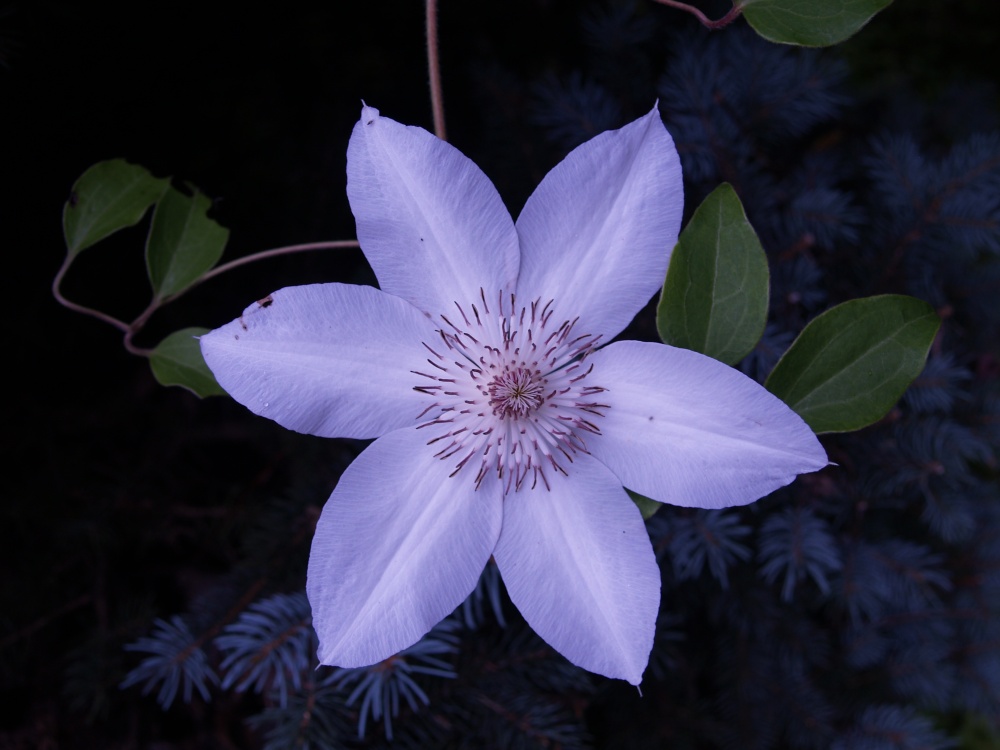
I have settled on clematis and passion vine for climbers. Passion vine is a bit aggressive, but the flowers so beautiful, and even the most vigorous clematis are easy to keep in bounds.
Invasives
Before the days of the Internet as an easily accessible garden reference, information about invasive plants was not widely available, and porcelain vine and others were frequently found in gardens. I’ll quarrel with a few plants determined to be “invasives” that are a problem in one area, but not in others, but there are plenty of great plants without using those that will escape your garden into the wild.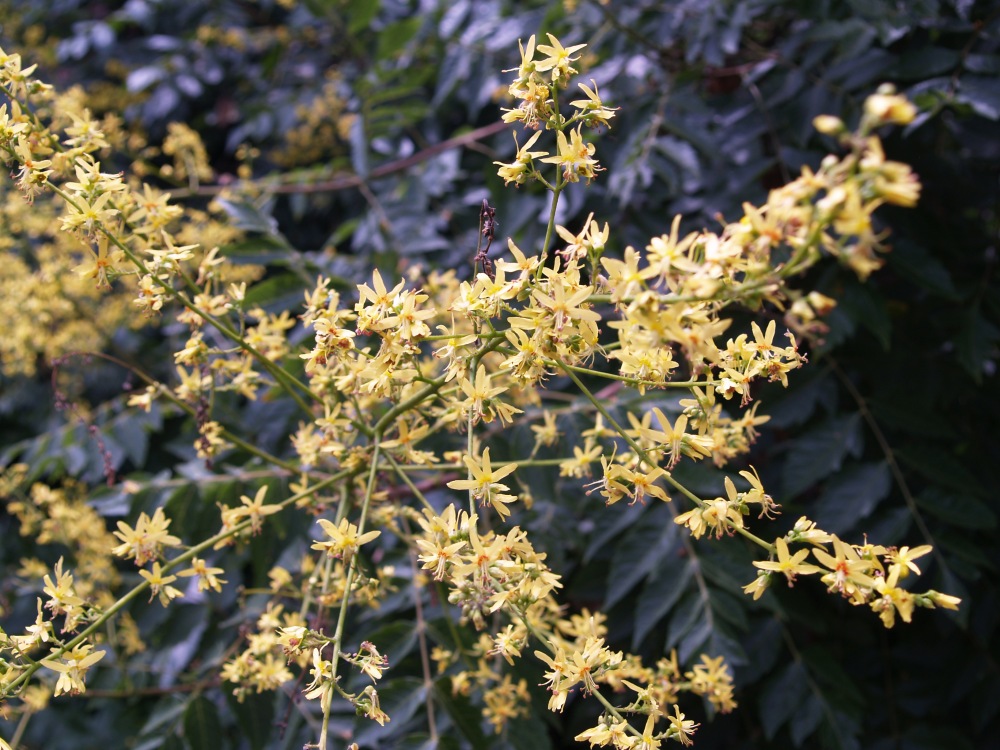
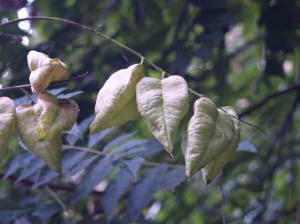 There are some plants that I’d like to add to my own invasive list. The Goldenrain tree (Koelreuteria paniculata, flowers above and seed pods at left) has lovely small yellow blooms in mid Summer, followed by interesting seed pods like small Chinese lanterns. Unfortunately, each pod contains hard, black, round seeds that germinate as a carpet under the tree, and pop up everywhere else in the garden. Every year I’m tempted to turn mine to firewood.
There are some plants that I’d like to add to my own invasive list. The Goldenrain tree (Koelreuteria paniculata, flowers above and seed pods at left) has lovely small yellow blooms in mid Summer, followed by interesting seed pods like small Chinese lanterns. Unfortunately, each pod contains hard, black, round seeds that germinate as a carpet under the tree, and pop up everywhere else in the garden. Every year I’m tempted to turn mine to firewood.
Planting too close
If you’ve followed this journal through the year you know I frequently comment on the hidden treasures I find that have been overwhelmed by larger neighbors. Some refuse to succumb, others disappear quietly.
The root of my problem is that I can’t quit planting. I see a plant that I just have to have, and I get it without any thought to where it might fit in, or even if it will. Once in hand it has to go somewhere, and it will probably work between this and that for a few years, and when it becomes a problem I’ll take care of it then. And that’s the end of that, until three years later when one or the other has to be moved or be lost and I’m too busy, or lazy, and it doesn’t get done. This happens a lot.
Planting too close to the house, walks, and paths
I mentioned my wife’s fascination with bamboo earlier, and she gets nearly as excited over plants that tumble onto the walkways and garden paths. I’m trying to cram as many plants in as possible, and she’s running about with her snippers cutting away every branch that strays into her path.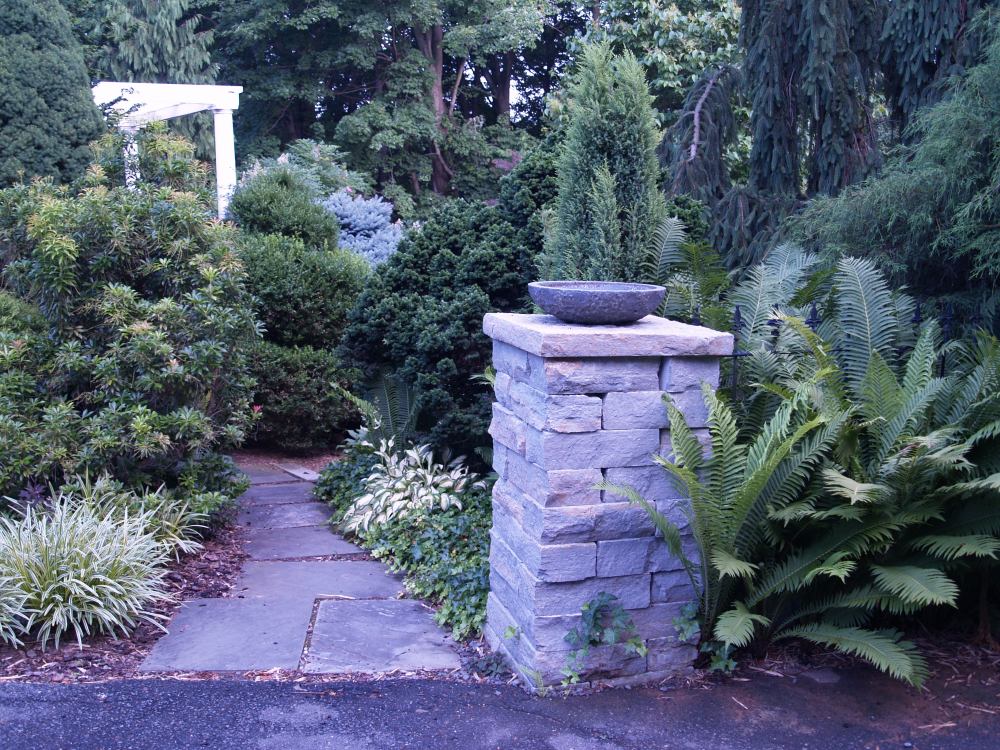
Today she’s threatening a large spiraled boxwood and a hinoki cypress that have obstructed the flagstone path from the driveway to the rear deck. Yes, they are too close, and yes, they’ll continue to grow. I don’t have the answers, I only know the damage wrought by her pruning.
Other areas are beyond the control of her pruners. The stone path up the slope on the far side of the house has been abandoned. The stepping stones go up the hill, then disappear into a jumble of hostas, ferns, and overhanging nandinas for ten feet, then the path reappears. I could divide and transplant the hostas and prune the nandinas, or just move the path, which is probably easier.
Enough disasters for one day! Lest we end the day on a sour note, here are a few of the joys of the garden. 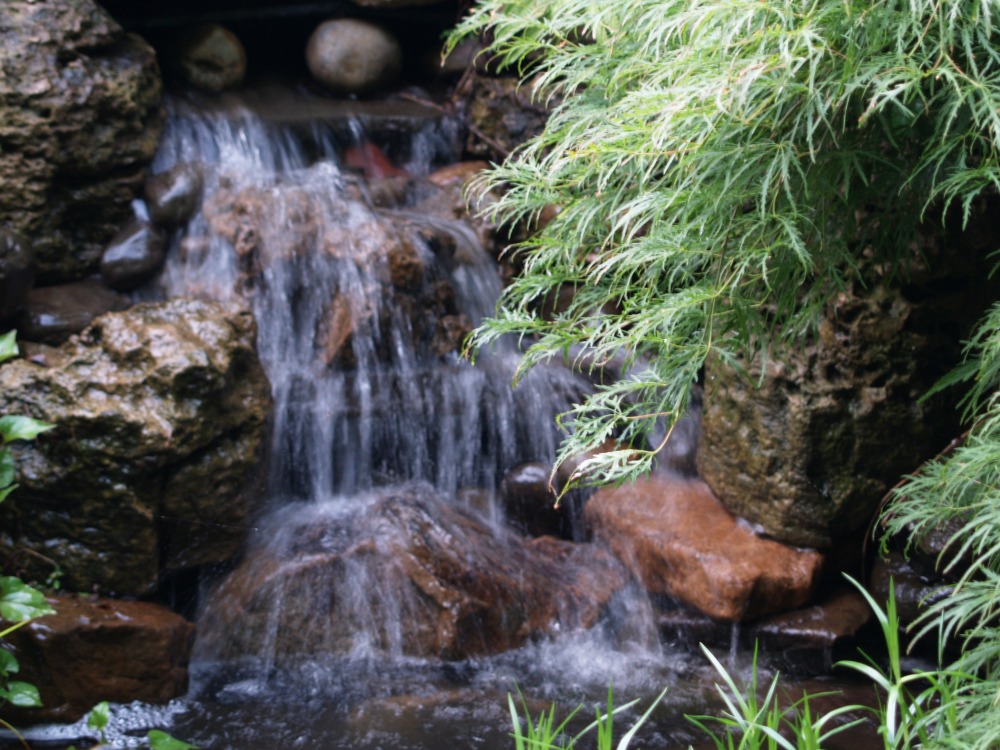
Ponds are good
I have six ponds, and can’t imagine my one acre garden without them. I spend less time caring for the ponds in a month than I do in a week on the lawn, and they’re far more beautiful and enjoyable. With little effort and expense with the exception of electricity for the recirculating pumps, the ponds are crystal clear, and alive with colorful koi and goldfish, frogs, and dragonflies.
Plant flowering trees and small trees with colorful foliage
I’ve decided that the essential elements to garden design are building a structural framework of paths, patios, garden ponds and buildings, and 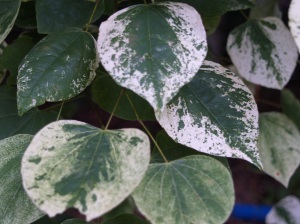 then framing the plantings with small flowering trees or those with colorful or interesting foliage. Shrubs and perennials are planted to complement the trees, the shade is never overpowering to the eye, and allows sun and shade loving plants to thrive. Even plants that demand full sun will appreciate a break from the scorching Summer heat.
then framing the plantings with small flowering trees or those with colorful or interesting foliage. Shrubs and perennials are planted to complement the trees, the shade is never overpowering to the eye, and allows sun and shade loving plants to thrive. Even plants that demand full sun will appreciate a break from the scorching Summer heat.
There are considerably more successes than failures in this garden.
The reader might think that this garden is a series of disasters, and it is true that every day, each week and month there are problems and failures. But, most plants thrive with little effort by the gardener, and every day holds immeasureable beauty.
Hi Dave, I just bought a japanese wisteria and researching on growing it. From your experience, it seems scary to plant one. The flowers are so majestic and yes I was tempted that i bought one. I intend to plant it next to the patio where there is a support beam. Please tell me if i have made the wrong decision to buy one and I will return it haha…Are the flowers very hard to clear when they start to bloom? How invasive are the roots? I seriously do not want to regret my decision to plant one.
After five or six years the trunk of my wisteria crushed a six inch diameter pine timber like a twig. I did not have a terrible problem controlling the top growth, though I have seen instances where wisteria has grown into mature trees.
I don’t think that the spent flowers will be much of a problem, but they do scatter seeds about, so you’ll have to keep up with pulling the seedlings. Beyond the wrecking of its support post the biggest issues have been once I cut the wisteria down, It’s been at least four or five years and still sprouts are growing from the roots.
I suppose I could be rid of it forever if I were to spray an herbicide, but there are a number of other plants in the area, so I’ve decided to keep pulling the sprouts until it runs out of energy. I think that I might run low before it does.
There are plenty of people who plant wisteria, and with proper management I am certain that it can be handled without being such a nightmare, but I won’t plant another. There is a less aggressive variety, Amethyst Falls, that has somewhat smaller blooms, and it reblooms sporadically through the summer, so it grows more slowly as more energy is expended in flowering.
Hi Dave and auOrey, Amethyst Falls is a cultivar of Wisteria frutescens, an American species. Aside from a few runners a season, the one I’ve planted and tried to train as a standard hasn’t gotten its trunk much bigger around than an inch diameter – AFTER 10 YEARS. It is only a quarter as aggressive as the Asian varieties, and because it’s native, I wouldn’t be worried if I were to plant it anywhere. I can’t say that of the beautiful but grossly thuggish Asian varieties. Frutescens will also bloom three to four times over the growing season. It’s only drawbacks are that its panicles look more like grape clusters and it’s not intoxicatingly fragrant.